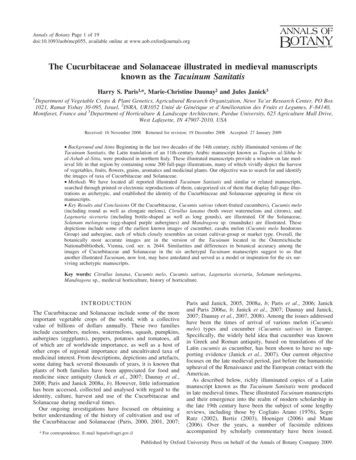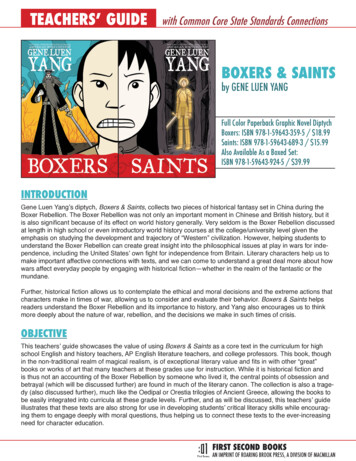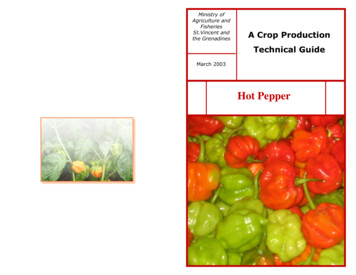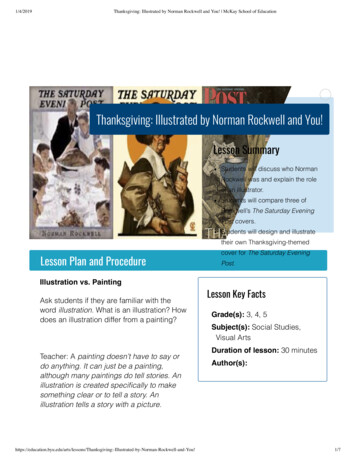
Transcription
Annals of Botany Page 1 of 19doi:10.1093/aob/mcp055, available online at www.aob.oxfordjournals.orgThe Cucurbitaceae and Solanaceae illustrated in medieval manuscriptsknown as the Tacuinum SanitatisHarry S. Paris1,*, Marie-Christine Daunay2 and Jules Janick31Department of Vegetable Crops & Plant Genetics, Agricultural Research Organization, Newe Ya’ar Research Center, PO Box1021, Ramat Yishay 30-095, Israel, 2INRA, UR1052 Unité de Génétique et d’Amélioration des Fruits et Legumes, F-84140,Montfavet, France and 3Department of Horticulture & Landscape Architecture, Purdue University, 625 Agriculture Mall Drive,West Lafayette, IN 47907-2010, USAReceived: 16 November 2008 Returned for revision: 19 December 2008 Accepted: 27 January 2009† Background and Aims Beginning in the last two decades of the 14th century, richly illuminated versions of theTacuinum Sanitatis, the Latin translation of an 11th-century Arabic manuscript known as Taqwim al-Sihha bial-Ashab al-Sitta, were produced in northern Italy. These illustrated manuscripts provide a window on late medieval life in that region by containing some 200 full-page illustrations, many of which vividly depict the harvestof vegetables, fruits, flowers, grains, aromatics and medicinal plants. Our objective was to search for and identifythe images of taxa of Cucurbitaceae and Solanaceae.† Methods We have located all reported illustrated Tacuinum Sanitatis and similar or related manuscripts,searched through printed or electronic reproductions of them, categorized six of them that display full-page illustrations as archetypic, and established the identity of the Cucurbitaceae and Solanaceae appearing in these sixmanuscripts.† Key Results and Conclusions Of the Cucurbitaceae, Cucumis sativus (short-fruited cucumbers), Cucumis melo(including round as well as elongate melons), Citrullus lanatus (both sweet watermelons and citrons), andLagenaria siceraria (including bottle-shaped as well as long gourds), are illustrated. Of the Solanaceae,Solanum melongena (egg-shaped purple aubergines) and Mandragora sp. (mandrake) are illustrated. Thesedepictions include some of the earliest known images of cucumber, casaba melon (Cucumis melo InodorousGroup) and aubergine, each of which closely resembles an extant cultivar-group or market type. Overall, thebotanically most accurate images are in the version of the Tacuinum located in the ÖsterreichischeNationalbibliothek, Vienna, cod. ser. n. 2644. Similarities and differences in botanical accuracy among theimages of Cucurbitaceae and Solanaceae in the six archetypal Tacuinum manuscripts suggest to us thatanother illustrated Tacuinum, now lost, may have antedated and served as a model or inspiration for the six surviving archetypic manuscripts.Key words: Citrullus lanatus, Cucumis melo, Cucumis sativus, Lagenaria siceraria, Solanum melongena,Mandragora sp., medieval horticulture, history of horticulture.IN T RO DU C T IO NThe Cucurbitaceae and Solanaceae include some of the moreimportant vegetable crops of the world, with a collectivevalue of billions of dollars annually. These two familiesinclude cucumbers, melons, watermelons, squash, pumpkins,aubergines (eggplants), peppers, potatoes and tomatoes, allof which are of worldwide importance, as well as a host ofother crops of regional importance and uncultivated taxa ofmedicinal interest. From descriptions, depictions and artefacts,some dating back several thousands of years, it is known thatplants of both families have been appreciated for food andmedicine since antiquity (Janick et al., 2007; Daunay et al.,2008; Paris and Janick 2008a, b). However, little informationhas been accessed, collected and analysed with regard to theidentity, culture, harvest and use of the Cucurbitaceae andSolanaceae during medieval times.Our ongoing investigations have focused on obtaining abetter understanding of the history of cultivation and use ofthe Cucurbitaceae and Solanaceae (Paris, 2000, 2001, 2007;* For correspondence. E-mail hsparis@agri.gov.ilParis and Janick, 2005, 2008a, b; Paris et al., 2006; Janickand Paris 2006a, b; Janick et al., 2007; Daunay and Janick,2007; Daunay et al., 2007, 2008). Among the issues addressedhave been the times of arrival of various melon (Cucumismelo) types and cucumber (Cucumis sativus) in Europe.Specifically, the widely held idea that cucumber was knownin Greek and Roman antiquity, based on translations of theLatin cucumis as cucumber, has been shown to have no supporting evidence (Janick et al., 2007). Our current objectivefocuses on the late medieval period, just before the humanisticupheaval of the Renaissance and the European contact with theAmericas.As described below, richly illuminated copies of a Latinmanuscript known as the Tacuinum Sanitatis were producedin late medieval times. These illustrated Tacuinum manuscriptsand their emergence into the realm of modern scholarship inthe late 19th century have been the subject of some lengthyreviews, including those by Cogliato Arano (1976), SegreRutz (2002), Bertiz (2003), Hoeniger (2006) and Mane(2006). Over the years, a number of facsimile editionsaccompanied by scholarly commentary have been issued.Published by Oxford University Press on behalf of the Annals of Botany Company 2009.
Page 2 of 19Paris et al. — Cucurbitaceae and Solanaceae of the Tacuinum SanitatisMore recently, electronic digitization by the bnf.fr/jsp/rechercheExperte.jsp), the Bibliothèque municipale de Rouen(France; http://bibliotheque.rouen.fr/repons/portal/portal) andthe Biblioteca Casanatense (Rome; http://opac.casanatense.it/SearchmanusMin.htm) has greatly eased access, facilitatingmore efficient study and comparison of these documents.Noteworthy is the book by Cogliati Arano (1976), which contains 43 colour and 243 black-and-white reproductions ofimages, with English translations of the brief accompanyingtexts, taken from five illustrated Tacuinum manuscripts.These reviews and commentaries contain a wealth of historic,artistic and descriptive information and comparative analysesof the different versions of the illustrated Tacuinum.However, little critical attention and analysis has beendevoted as yet to the images of plants by specialists of particular plant families.Our interest in the Tacuinum focuses on the remarkable fullpage illustrations as they relate to horticulture. Among theillustrations are particularly vivid depictions of the harvest ofvegetables, fruits, flowers, grains, and aromatic and medicinalplants, which can provide substantial information on insufficiently investigated cultivated plants of the late medievalperiod. As will be shown, although the botanical details areoften missing or erroneous, the depictions are valuable foridentifying the crop plants known from late medieval northernItaly. Our specific objective was to identify the taxa ofCucurbitaceae and Solanaceae present in the illustrated versions of the Tacuinum Sanitatis.HI S TO R I CA L CON T E XTProduction of the lavishly illuminated Latin manuscriptsknown as the Tacuinum Sanitatis was begun in northernItaly in the last decades of the 14th century (Cogliato Arano,1976; Segre Rutz, 2002; Bertiz, 2003; Hoeniger, 2006;Mane, 2006). These were manuals of health derived from theunillustrated Taqwim al-Sihha bi al-Ashab al-Sitta(Rectifying Health by Six Causes), an 11th-century Arabicmanuscript written by the Christian physician and philosopherAbu al-Hasan al-Mukhtar ibn al-Hasan ibn ‘Abdun Ibn Sa’dunibn Butlan (d. 1063), who was born and educated in Baghdadand whose travels took him to localities that are today in Iraq,Syria, Egypt, Israel and Turkey (Elkhadem, 1990). TheTaqwim was a synthesis derived from Greek medical scienceand tradition, and served as a guide for healthy living,tersely summarizing components of health in a tabular formof 15 columns. Some 280 items were considered to behealth-related, covering food and drink, climate and bodilyactivities, all of them to be balanced as a regimen for ahealthy lifestyle. Elkhadem listed 16 surviving copies of theTaqwim, all but one of which he was able to access andcompare. Translation of the Taqwim into Latin was commissioned by the Court of Naples and Sicily and completed by1266. This translation, although not perfect, was consideredby Elkhadem to be faithful to the text of Ibn Butlan. TheLatin version, which was to become known as the TacuinumSanitatis, was copied repeatedly and circulated in Europe.Bertiz listed 14 depositories of copies of the Tacuinum.Over 100 years after the first Tacuinum was prepared, in thelast quarter of the 14th century, the first illuminated copies of itwere commissioned of artists by northern Italian nobility(Cogliato Arano, 1976; Segre Rutz, 2002; Hoeniger, 2006).These illustrated Tacuinum manuscripts were among thediverse artistic creations that had been commissioned by thewealthy at that time, and most of the illustrations are idealizedsnapshots of daily life and seasonal activities in the countryside, with nobles engaged in supervision, sport and romanceand feudal labourers at their daily toil. The poverty, warsand plagues that occurred in that region during the secondhalf of the 14th century are ignored. The garden was anisland of joy, serenity, recreation and amusement. As such, itwas thought to lead to a sunny mental disposition, whichwas considered to be a valuable component of the maintenanceand restoration of health (Bertiz, 2003).The number of items found in the illustrated Tacuinummanuscripts of northern Italy is reduced as compared withthe 280 items of the Taqwim. Unfamiliar items of the NearEast were deleted or replaced by foods or subjects familiarto the local, northern Italian audience (Segre Rutz, 2002;Hoeniger, 2006). The text was markedly abridged. Short paragraphs, indeed selected extracts, substitute for the categorizedtabulations and they occupy only a small portion of each folioin the illustrated Tacuinum manuscripts. Occupying most ofthe space of each page, above the text, is a large illustrationof the subject matter. Each of the illustrated Tacuinum manuscripts contains approx. 200 depictions of plants, animals,agricultural practices and people. However, these Tacuinummanuscripts are not exact copies of one another. Not only doillustrations of the same item differ among them, there are anumber of items that appear in one or more copies that donot appear in others and vice versa (Delisle, 1896). Theseillustrated manuscripts were, in effect, individualized, expensive coffee-table books directed to meet the demands of theirelite commissioners.Giangaleazzo Visconti (1351 –1402), the Count of Milanand owner of a large feudal estate in the Po Valley(Lombardy, northern Italy), is thought to have commissionedthe first illustrated versions of the Tacuinum from the workshop of the famous artist Giovannino de Grassi (Hoeniger,2006). Three of the illustrated Tacuinum manuscripts, Paris1673, Vienna 2644 and Rome 4182 (Table 1), are consideredto have been produced in Lombardy during the last twodecades of the 14th century by various artists employed inGiovannino de Grassi’s workshop (Cogliati Arano, 1976). Afourth Tacuinum manuscript, Liège 1041, is thought to havebeen produced first (Cogliati Arano, 1976) or just after theother three in the neighbouring western Veneto region (SegreRutz, 2002; Hoeniger, 2006). Two other Tacuinum manuscripts are thought to have been produced later, during themid-15th century. One of these, Paris 9333, is considered tohave been copied by a German artist from Vienna 2644(Bertiz, 2003; Mane, 2006). The other, Rouen 3054/Liechtenstein, is a derivative of Rome 4182 but was separatedinto two parts in the 19th century, one part of which is now inRouen (France) and the other in the hands of a private collector (Segre Rutz, 2002; Bertiz, 2003; Bovey, 2005). We categorize these six manuscripts as archetypes. All six consistof full-page depictions showing plants growing in situ, in
Paris et al. — Cucurbitaceae and Solanaceae of the Tacuinum SanitatisPage 3 of 19TA B L E 1. Extant Tacuinum Sanitatis and related manuscriptsText referenceDepositoryCatalogue no.Manuscript typeDate*Paris 1673Liège 1041Vienna 2644Rome 4182Paris 9333Rouen 3054/LiechtensteinBibliothèque Nationale de France, ParisBibliothèque de l’Université de LiègeÖsterreichische Nationalbibliothek, ViennaBiblioteca Casanatense, RomeBibliothèque Nationale de France, ParisBibliothèque municipale, Rouen, and private collection†Nouv. Acq. Lat. 1673Ms. 1041Cod. Ser. N. 2644Ms. 4182Latin 9333Ms. 3054 [Leber ��14001445–14511450sVienna 2396Rome 459Granada C67Paris 1108Vienna 5264Lugano 15Österreichische Nationalbibliothek, ViennaBiblioteca Casanatense, RomeBiblioteca del hospital Real, Universidad de GranadaBibliothèque Nationale de France, ParisÖsterreichische Nationalbibliothek, ViennaBibliothèque Internationale de Gastronomie, LuganoMs. 2396 [Eug. Q. 59]Ms. 459Ms C67 [BHR/Caja A-001]Italien 1108Ms. 5264 [Med. 2]Ms. omposite1476–1500c. 14001440–14451470–14751470–14751470–1475* Dates are according to Cogliati Arano (1976), Opsomer-Halleux (1991), Segre Rutz (2002), Bovey (2005), and/or Hoeniger (2006), and/or respectivedepository catalogues and websites.†The Rouen 3054 and Liechtenstein manuscripts are actually two parts of the same Tacuinum manuscript, separated from one another in the 19th century(Bertiz, 2003; Bovey, 2005).‡Archetypes of the Tacuinum Sanitatis are considered as displaying plants growing in a garden or field depicted, together with a text extract, on a full page.§This manuscript is considered a variant because it displays market scenes, four per page.}Composites are herbals that contain some images displaying plants growing in a garden or field; not all accompanying text is derived from Ibn Butlan.#According to Segre Rutz (2002), another manuscript, New York Public Library Spencer Collection ms. 65, is closely related and similar to Paris 1108,Vienna 5264 and Lugano 15.a field or garden, instead of a single detached plant specimenas according to the herbal tradition (Hoeniger, 2006).The six extant archetypal Tacuinum manuscripts are listed inTable 1 together with their depositories, catalogue numbersand their shortened designations for use herein. As far as isknown, the present report is the first to consider andcompare all six of these manuscripts, although it is restrictedto two plant families. Chronology and year of production ofthese manuscripts is not entirely certain and is still debatedby scholars, and each of the dates is presented as a span ofyears. According to Segre Rutz (2002) and Hoeniger (2006),it is likely that more Tacuinum manuscripts existed in additionto these six, but they have either been lost or destroyed.Other works listed in Table 1 are related to the six illustratedarchetypal Tacuinum manuscripts but differ from them inlayout and overall content. They will not be considered indepth here for several reasons. Vienna 2396 is a variant fromthe archetype because the layout consists of four images perpage instead of a single large one. Also, the images containingcucurbits depict market scenes, rather than gardens or fields,and although pleasing artistically, they greatly lack botanicaldetail and accuracy. The other five manuscripts, Rome 459,Granada C67, Paris 1108, Vienna 5264, and Lugano 15, arecategorized as composites because they include wild plantsas well as garden plants, and many of the images are in theherbal tradition, showing individual plants or plant parts.They include illustrations of a number of genera from theCucurbitaceae and Solanaceae that do not appear in the archetypal Tacuinum manuscripts, including Bryonia, Ecballium,Hyoscyamus, Momordica, Physalis (alkekenge) and Solanum(nightshades). Another composite manuscript exists in theNew York Public Library, Spencer Collection ms. 65(New York 65), but it has only been possible to access a fewof the illustrations within it. According to Segre Rutz(2002), New York 65, Paris 1108, Vienna 5264 and Lugano15 were produced at about the same time, around 1470 orso, in the workshop managed by Giovanni Cadamosto ofLodi. These four are reportedly quite similar to one anotherin format, having two illustrations per page of a modestquality.Bertiz (2003) listed six printed editions of the Tacuinumfrom the 1530s. These are quite different from the illuminatedmanuscript copies of the Tacuinum, instead being more similarto the Taqwim by containing Ibn Butlan’s elaborate information in tabular form. Moreover, the woodcut imageswithin are quite small, only 2 – 3 cm in height, and placed atthe bottom of the page in a horizontal band.THE IMAGESThe illustrations of most of the respective subjects are similarto one another in four of the six archetypal illuminatedTacuinum manuscripts: Vienna 2644, Rome 4182, Paris 9333and Rouen 3054/Liechtenstein (Table 1). In all four, the illuminations are brilliantly coloured and focus primarily on theplants in gardens and fields. The artists even made efforts todepict various small weeds as growing in the gardens. Inthree of these, Vienna 2644, Rome 4182 and Rouen 3054/Liechtenstein, the lower border of the illustrations is depictedas creviced soil. Possibly, the cracks represent a drying out ofthe soil outside of the plots, which would suggest that thecrops were selectively irrigated. Differing markedly fromthese four manuscripts are the Liège 1041 and Paris 1673manuscripts, which focus on social interactions and on architecture, the plants having less detail and accuracy. In theLiège manuscript, the plants are highlighted in colouragainst the otherwise sepia-lined people and buildings, andsometimes are afforded the protection of a courtyard.Cucurbit vines are normally procumbent, unless trained orallowed to grow on a structure. The procumbency is accuratelydepicted in Rome 4182, Rouen 3054 and Liège 1041. In contrast, several of the cucurbits are depicted as erect, without the
Page 4 of 19Paris et al. — Cucurbitaceae and Solanaceae of the Tacuinum Sanitatisaid of any support, in Vienna 2644, Paris 9333 and, especially,in Paris 1673. Apparently, this was a pictorial device employedby the illuminators to provide the viewer with a perspectivethat maximizes the amount of information about the subject(Bertiz, 2003). Moreover, the crops are idealized and, althoughflowers and young fruits are often absent, the plants are shownas bountifully producing ripe fruits. Often, too, the size of thefruits is exaggerated and, indeed, little attention is paid to thecorrect proportional and spatial relationships among the plantparts (Hoeniger, 2006).Four species of Cucurbitaceae and two genera of Solanaceaecan be clearly identified in these six archetypal illustratedTacuinum manuscripts (Table 2). Each of the six taxa ofCucurbitaceae and Solanaceae will be considered separately,across the six manuscripts, but not all of the taxa or their variants appear in all of the manuscripts. Overall, Vienna 2644has the most botanically accurate depictions and hence, foreach taxon or variant, the illustrations in this Tacuinum willbe presented and considered first whilst the depictions in theParis 1673 Tacuinum, which in most cases are the least accurate, will be presented and considered last. The similar illustrations appearing in Vienna 2644, Paris 9333, Rome 4182and Rouen 3054/Liechtenstein are, whenever possible, presented together in a block for easy comparison, followed bythe quite distinct Liège 1041 and Paris 1673 illustrations. Asthe labels of the illustrations are not always consistentwith the plants depicted, they are listed in Table 2 togetherwith the corresponding taxonomic identity of the plants.It was not possible to access a translation of the brief accompanying paleographic Latin writing for all of the illustrations.The translations of texts that are alluded to below can be foundin Cogliato Arano (1976) and Opsomer-Halleux (1991).TA B L E 2. Cucurbitaceae and Solanaceae illustrated in the six archetypal Tacuinum Sanitatis manuscriptsTaxon, common nameManuscriptFolio no.LabelCucumis sativus, short-fruited cucumberVienna 2644Paris 9333Liège 104123v20v20vCucumeres & citruliCucumeres et citruliCucumeres et citrolliCucumis melo, Chate GroupRome 4182Rouen 305440r20vCucumeres et citruliCucumeres & citruliCucumis melo, Inodorous Group, casaba melonParis 167338vCucumeres & cetruliCucumis melo, Flexuosus Group, snake melonLiège 104119vLangurieCucumis melo, Adana Group?Vienna 2644Paris 9333Rome 4182Rouen 3054Liège 1041Paris 167322r19r36r18v19r37vMelones indi i palestiniMelones indi i palestiniMelones insipidiMelones insipidiMelonus inzibidiMelones isipidiCitrullus lanatus, watermelonVienna 2644Paris 9333Rome 4182Rouen 3054Liège 1041Paris 167321r18r35r18r20r37rMelones dulcesMelones dulcesMelones dulcesMelones dulcesMellones dulcesMelones dulcesCitrullus lanatus, citron watermelonVienna 2644Paris 9333Rome 4182Rouen 3054Paris 167321v18v37r19r38rMelones insipidiMelones insipidiMelones indi i palestiniMelones indi i palestiniMelones palestiniLagenaria siceraria, calabash, bottle gourdVienna 2644Paris 9333Rome 4182Rouen 3054Liège 1041Paris ucurbiteCucurpideCucurbiteSolanum melongena, aubergine, eggplantVienna 2644Paris 9333Rome 4182Rouen 3054Paris elongianaMelongianeMandragora sp., mandrakeVienna 2644Paris 9333Rome 4182LiechtensteinLiège 1041Paris 167340r37r73r13r16v85rFructus mandragoreFructus mandragoreFructus mandragoreFructus mandragoreFructus mandragoreFructus mandragore
Paris et al. — Cucurbitaceae and Solanaceae of the Tacuinum SanitatisCucumis sativus L. (cucumber, Cucurbitaceae); Fig. 1Vienna 2644 folio 23v (Fig. 1A) depicts two gowned figuresharvesting fruits from viney plants having undivided leavesand small yellow flowers. The fruits are shown as somewhatlonger than the length of a hand, short cylindrical, and tuberculate, indicating cucumbers, Cucumis sativus. The intenseyellow colour of the fruits indicates that they are ripe, theaccompanying short paragraph stating that the fruits are bestchosen as fully grown but before they turn yellow. Theimage in Paris 9333 folio 20v (Fig. 1B) is similar, the fruit surfaces appear to be uneven but tubercules are not defined. Theimage in the Liège 1041 folio 20v (Fig. 1C) depicts two taxa,one of these appears to be cucumber and the other a citron tree,Citrus medica L. (Rutaceae). The lower image shows a simplified, prostrate plant with green foliage and short cylindrical,yellow fruits about the length of a hand. Two of theseappear to have an uneven surface, consistent with cucumbers,C. sativus. The citrus tree is shown bearing large, yellow fruits,also having an uneven surface. The bipartite label, Cucumereset citrolli, suggests that citrolli is here interpreted to be citronbut in other Tacuinum manuscripts, in which the citron appearsalone, it is labelled differently.Page 5 of 19ABCucumis melo L. (melon, Cucurbitaceae); Figs 2 and 3(1) Rome 4182 folio 40r (Fig. 2A), also labelled Cucumeres etcitruli (Table 1), shows viney plants having cordate leavesbearing white flowers. The fruits are short cylindrical,slightly longer than the leaf laminae, green-yellow withorange-yellow stripes that are contiguous over the entirelength of the fruit. This striping precludes cucumber,Cucumis sativus, but is entirely consistent with chatemelon, C. melo subsp. melo Chate Group (syn. AdzhurGroup) (Pitrat et al., 2000) which, like cucumber, isgrown for consumption of its immature fruits. Theyellow colouration of the fruits indicates that they aremature, well beyond their usefulness as an esculent.Rouen 3054 folio 20v (Fig. 2B) is similar, also erroneously showing white flowers.(2) Paris 1673 folio 38v (Fig. 2C), also labelled Cucumeres &cetruli (Table 1), depicts a vine bearing alternating leaveswith undivided to slightly divided laminae that are acute atthe apex. Some of the leaves are coloured green, othersbrown, perhaps to indicate the adaxial and abaxial leaf surfaces. No flowers are depicted. What is unique about thisimage, though, is that, when examined carefully, thelong oval, pale fruits, larger than the size of a hand, canbe seen to be wrinkled, the same as modern casabamelons, Cucumis melo subsp. melo Inodorous Group.(3) Liège 1041 folio 19v (Fig. 2D), labelled Langurie, depictsa simplified, prostrate, viney plant bearing acutely cordatelaminae and long, narrow, green, striate fruits. The fruitsare of considerably greater length than a hand. A kneelingwell-dressed woman holds a plate having four long,narrow, green fruits, offering them to two nobly dressedmen. The shape and striations of the fruits leave nodoubt that this image depicts snake melon, Cucumismelo subsp. melo Flexuosus Group. The text advises thatthe best ones are sweet and watery.CF I G . 1. Cucumbers, Cucumis sativus, depicted in the Tacuinum Sanitatis: (A)Vienna 2644 folio 23v, (B) Paris 9333 folio 20v, (C) Liège 1041 folio 20v.
Page 6 of 19Paris et al. — Cucurbitaceae and Solanaceae of the Tacuinum SanitatisABCDF I G . 2. Melons, Cucumis melo subsp. melo, depicted in the Tacuinum Sanitatis: (A, B) Chate melons (Rome 4182 folio 40r, A; Rouen 3054 folio 20v, B);(C) casaba melons (Paris 1673 folio 38v); (D) snake melons (Liège 1041 folio 19v).(4) Vienna 2644 folio 22r (Fig. 3A) depicts several plantsgrowing in a garden with the label Melones indi i palestini.The vines are not dense, have cordate leaf laminae, smallyellow flowers, and bear round, entirely yellow fruitsslightly larger than a person’s head. Two people areamong the vines. A lady dressed in a blue gown ispicking a fruit and a man in a red tunic with blue tightsholds a fruit to his nose, indicating that the fruits are aromatic. The shape, colour and fragrance of the fruits leaveno doubt that a type of melon, Cucumis melo, is depicted.The scenery in Paris 9333 folio 19r (Fig. 3B) hardlydiffers except for the clothing, lack of soil cracks, andgreen colouration of the ground. An entirely differentdepiction is given the same label, Melones indi i palestini,in the Rome 4182 and Rouen 3054 manuscripts (seebelow), but similar depictions are labelled Melonesinsipidi for Rome 4182 folio 36r (Fig. 3C) and forRouen 3054 folio 18v (Fig. 3D). Evidently, the imagesor the labels got switched. Both of the images lackpeople but do show plants bearing fruits that are roundand yellow, about the same size or larger than thecordate leaf laminae. The flowers, however, are incorrectlydepicted as white. The Rouen manuscript depicts thefoliage as thinned out, more revealing of the fruits,which are of an intense yellow. Liège 1041 folio 19r(Fig. 3E) carries the label Melonus inzibidi for a simplifiedplant bearing yellow-green, lobed fruits, two characteristics which are consistent with C. melo. Paris 1673 folio37v (Fig. 3F), labelled Melones isipidi, shows twowomen with an individual viney plant having acute, undivided leaf laminae, no flowers, and oval, yellow-greenfruits nearly the same size as a person’s head. All ofthese six images appear to represent melons of C. melosubsp. melo Adana Group. The text indicates that theyare lemon-coloured and that the best ones are large,sweet and watery, indicating that they are used when ripe.
Paris et al. — Cucurbitaceae and Solanaceae of the Tacuinum SanitatisABCDEFPage 7 of 19F I G . 3. Melons, Cucumis melo subsp. melo, possibly adana melons, depicted in the Tacuinum Sanitatis: (A) Vienna 2644 folio 22r; (B) Paris 9333 folio 19r;(C) Rome 4182 folio 36r; (D) Rouen 3054 folio 18v; (E) Liège 1041 folio 19r; (F) Paris 1673 folio 37v.
Page 8 of 19Paris et al. — Cucurbitaceae and Solanaceae of the Tacuinum SanitatisCitrullus lanatus (Thunb.) Matsum. & Nakai (watermelon,Cucurbitaceae); Figs 4 and 5(1) Vienna 2644 folio 21r (Fig. 4A), labelled Melones dulces,is a depiction of watermelon plants growing in a field orgarden. In the jungle of vines, a man in a grey tunic isshown among the plants, steadying a fruit in one handand holding a knife in the other, about to cut the fruitfrom the plant. The fruits leave no doubt as to the intendedidentity of the crop, as they are long oval, dark and lightgreen-striped, larger than a man’s head, and several ofthem have burst or been sliced open to reveal red flesh.The flowers are correctly depicted as small and yellowbut the leaf laminae are not depicted realistically as theyare shown as being entire instead of pinnatifid. The depiction of Paris 9333 folio 18r (Fig. 4B) is quite similar,showing a man in grey crouching over a watermelon thathe is about to pick, and two burst or sliced watermelonshaving a red interior. Rome 4182 folio 35r (Fig. 4C) isinaccurate not only for the shape of the leaf laminae, butalso for the white colour of the flowers. The size andexterior colouration of the fruits is similar to that shownin Vienna 2644 and Paris 9333. A crouching mandressed in a red tunic is about to cut a fruit from theplant, but none of the fruits show the flesh. Rouen 3054folio 18r (Fig. 4D) is a simplified version of the picturein the Rome 4182 manuscript, in that the foliage hasbeen thinned out, but is otherwise almost the same.Liège 1041 folio 20r (Fig. 4E) depicts five people in acourtyard and a highly simplified single plant, havingbut a few undivided leaves, no flowers, and several oval,yellow-green fruits that are striated, differing in size andprobably reflective of differing stages of development,the larger, more mature ones about the same size andshape as in the other Tacuinum manuscripts. Hence theiridentity as watermelon is probable, even though notentirely certain, unless this illustration is considered inlight of those with the Melones dulces labe
The Cucurbitaceae and Solanaceae illustrated in medieval manuscripts known as the Tacuinum Sanitatis Harry S. Paris1,*, Marie-Christine Daunay2 and Jules Janick3 1Department of Vegetable Crops & Plant Genetics, Agricultural Research Organization, Newe Ya’ar Research Center, PO Box 1021, Ramat Yishay










